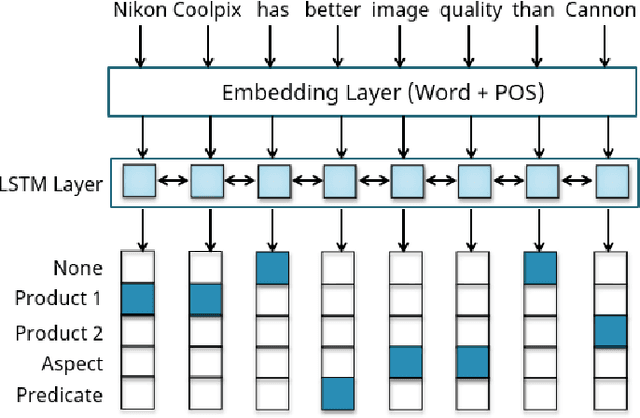Jatin Arora
Extracting Entities of Interest from Comparative Product Reviews
Oct 31, 2023



Abstract:This paper presents a deep learning based approach to extract product comparison information out of user reviews on various e-commerce websites. Any comparative product review has three major entities of information: the names of the products being compared, the user opinion (predicate) and the feature or aspect under comparison. All these informing entities are dependent on each other and bound by the rules of the language, in the review. We observe that their inter-dependencies can be captured well using LSTMs. We evaluate our system on existing manually labeled datasets and observe out-performance over the existing Semantic Role Labeling (SRL) framework popular for this task.
* Source Code: https://github.com/jatinarora2702/Review-Information-Extraction
Split-NER: Named Entity Recognition via Two Question-Answering-based Classifications
Oct 30, 2023Abstract:In this work, we address the NER problem by splitting it into two logical sub-tasks: (1) Span Detection which simply extracts entity mention spans irrespective of entity type; (2) Span Classification which classifies the spans into their entity types. Further, we formulate both sub-tasks as question-answering (QA) problems and produce two leaner models which can be optimized separately for each sub-task. Experiments with four cross-domain datasets demonstrate that this two-step approach is both effective and time efficient. Our system, SplitNER outperforms baselines on OntoNotes5.0, WNUT17 and a cybersecurity dataset and gives on-par performance on BioNLP13CG. In all cases, it achieves a significant reduction in training time compared to its QA baseline counterpart. The effectiveness of our system stems from fine-tuning the BERT model twice, separately for span detection and classification. The source code can be found at https://github.com/c3sr/split-ner.
Attention-based Joint Detection of Object and Semantic Part
Jul 05, 2020



Abstract:In this paper, we address the problem of joint detection of objects like dog and its semantic parts like face, leg, etc. Our model is created on top of two Faster-RCNN models that share their features to perform a novel Attention-based feature fusion of related Object and Part features to get enhanced representations of both. These representations are used for final classification and bounding box regression separately for both models. Our experiments on the PASCAL-Part 2010 dataset show that joint detection can simultaneously improve both object detection and part detection in terms of mean Average Precision (mAP) at IoU=0.5.
Finding Input Characterizations for Output Properties in ReLU Neural Networks
Mar 09, 2020


Abstract:Deep Neural Networks (DNNs) have emerged as a powerful mechanism and are being increasingly deployed in real-world safety-critical domains. Despite the widespread success, their complex architecture makes proving any formal guarantees about them difficult. Identifying how logical notions of high-level correctness relate to the complex low-level network architecture is a significant challenge. In this project, we extend the ideas presented in and introduce a way to bridge the gap between the architecture and the high-level specifications. Our key insight is that instead of directly proving the safety properties that are required, we first prove properties that relate closely to the structure of the neural net and use them to reason about the safety properties. We build theoretical foundations for our approach, and empirically evaluate the performance through various experiments, achieving promising results than the existing approach by identifying a larger region of input space that guarantees a certain property on the output.
 Add to Chrome
Add to Chrome Add to Firefox
Add to Firefox Add to Edge
Add to Edge